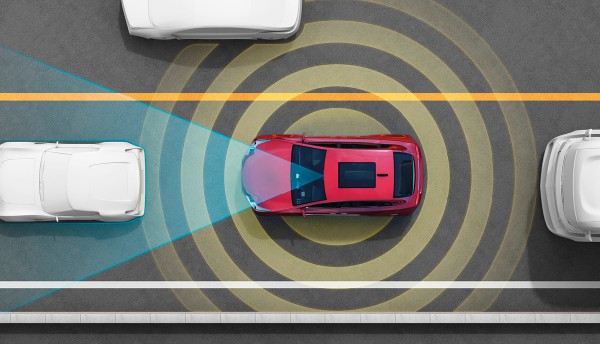
Q&A with Forvia Hella
High-resolution radar is a key technology for autonomous driving, providing essential capabilities that enhance vehicle safety and operational efficiency. To learn more, we spoke to Jürgen Maisel, director of Radar Scouting & Future Architecture at Forvia Hella.
Unlike traditional radar systems, high-resolution radar (HRR) offers improved accuracy in detecting distances, angles and velocities, enabling multiple object tracking and precise obstacle detection. This function is vital for automated driving levels SAE L3 and beyond, where safety and situational awareness are paramount. One primary advantage of the high-resolution radar is its performance in various environmental conditions, including low-visibility scenarios such as fog or heavy rain, where cameras and Lidar may struggle. This ability allows autonomous vehicles to navigate complex situations safely. Advancements in high-resolution radar will likely focus on refining sensor fusion algorithms and integrating data from multiple sensor types such as cameras and Lidar. This will create a more comprehensive understanding of the vehicle's surroundings, improving decision-making processes. The development of wider aperture radar systems will further elevate resolution and accuracy for better differentiation between various objects, such as pedestrians and cyclists. As these technologies evolve, high-resolution radar will play a pivotal role in achieving higher levels of autonomy and ensuring safer roadways for all users.
Forvia Hella is a prominent player in the automotive technology sector, specializing in innovative solutions that enhance vehicle safety and automation. Its high-resolution radar capabilities provide advanced detection and tracking features essential for autonomous driving and advanced driver assistance systems (ADAS).

Jürgen Maisel (Source: Forvia Hella)
Key takeaways:
- Imaging radar or HRR offers high accuracy and resolution for detection capabilities. The term HRR is preferred for precision, while "4D" refers to the technology‘s physical detection capabilities.
- HRR improves autonomous driving by providing precise measurements that enhance multi-object tracking. It complements traditional sensors such as cameras and Lidar, ensuring consistent performance across various weather conditions and facilitating higher levels of automation.
- By 2030, vehicles for higher automation levels (3, 4 or 5) will likely require multiple HRR for comprehensive coverage. A full 360° radar belt will be essential, with at least one front radar being high-resolution to ensure safety and situational awareness.
- Interior radars enhance vehicle safety and health monitoring by detecting occupant presence and monitoring vital signs. Forvia Hella plans to launch an ultra-wideband solution that integrates Child Presence Detection via software, leveraging existing vehicle access systems without additional hardware.
The following is an edited transcript of the conversation.
S&P Global Mobility: Can you describe the significance of 4D or imaging radar in the evolution of radar technology?
Jürgen Maisel: Currently, two names are used for this advanced technology: 'Imaging radar' or 'high-resolution radar.' In both cases, the radars offer advanced detection capabilities with high accuracy and resolution, based on the same technological principle. As the term ‘imaging’ is technically not entirely precise, we prefer to use the name high-resolution radar (HRR).
The term ‘4D’ alone describes the different physical detection capability — not the resolution and accuracy. Radars with 4D capabilities are currently being developed in two different variants: As a cost-optimized standard radar and as a performance-oriented HRR.
The HRR makes a significant contribution to autonomous driving because it provides the required detection sensitivity, resolution and detection accuracy.
What new use case brings the first 4D or imaging radar to market?
The first 4D high-resolution radar, or sometimes referred to as imaging radar, revolutionizes mobility by enabling advanced driver assistance systems (ADAS) and autonomous driving. Its precise 4-dimensional detection capabilities — distance, angle in azimuth, angle in elevation and velocity with high resolution — enable reliable multi-object tracking and detection of obstacles, which makes this radar type indispensable for the automated driving levels SAE L3 and beyond.
Its ability to provide an accurate 'image' of the environment in real time enhances safety and reliability, ensuring consistent performance in all weather conditions. Overall, this advancement in the radar technology significantly improves vehicle automation and safety.
In what ways does imaging radar improve automated driving or enable higher levels of automation, such as in navigating tricky situations, managing false-positives or filling a performance gap in other common sensors like camera, traditional radar or lidar?
High-resolution radar improves autonomous driving by providing precise distance, angular and velocity measurements, enhancing multi-object tracking and ensuring reliable real-life performance in a broad range of weather conditions. Radar perfectly complements cameras and Lidar by offering consistent, real-time data regardless of visibility conditions, for example at nighttime or during fog.
This reliability and precision enable higher levels of automation and safer, more effective autonomous driving.
Considering advances in automated driving and autonomy levels, how many 4D or imaging radars do you believe will be required in a vehicle in 2030?
By 2030, it is likely that vehicles equipped for higher levels of automation (Level 3, 4 or 5) for highway and suburban driving environments will require multiple high-resolution radars to ensure comprehensive coverage and enhanced safety. As an example, a vehicle with an SAE level 3 needs to be equipped with a full 360° radar belt, while the exact number of radars in a belt depends on the E/E architecture of the vehicle.
It is essential that at least one radar in the front is a high-resolution radar, while all other radars in the 360° radar belt (corner, side, etc.) will be standard sensors. In some cases, it is possible that high-resolution radars are used as well as additional rear radars.
Nevertheless, the standard radars will evolve to higher resolution and performance as well. Therefore, in total, a fully autonomous vehicle might require several high-resolution radars to achieve comprehensive situational awareness and ensure the high levels of safety and reliability that are needed for autonomous driving.
How can interior radar be utilized for occupant detection and health monitoring within vehicles?
Interior radars in vehicles are one technological solution to enhance safety and health monitoring by detecting the presence and positioning of occupants as well as left-behind children or pets. It monitors vital signs like heart and respiratory rates, assesses driver alertness and identifies stress levels through breathing patterns. These capabilities ensure optimal deployment of safety systems, provide early warnings for health issues, and adjust the settings for occupant comfort, thus contributing to a safer and more comfortable driving experience.
As Forvia Hella, however, we will soon be launching a solution for interior monitoring based on ultra-wideband for a first large-volume series project. The advantage here is that we can build on a digital vehicle access system that we are bringing into series production for the customer — while implementing Child Presence Detection as an additional function via software without the need for extra hardware.
Can 4D or imaging radars potentially replace or augment Lidar sensors? Or are imaging radar and Lidar more likely to coexist in vehicles?
If high-resolution radar technology continues to develop at its current pace, it could eventually possess the capabilities to replace Lidar sensors in vehicles. The chip technology is one of the key enablers. Talking about autonomous driving, we have to consider legal aspects as well: As of today, Lidar sensors are still necessary for [autonomous driving] vehicles.
How does imaging radar compare to traditional radar and to Lidar sensors in terms of cost?
High-resolution radars are initially performance-oriented and therefore obviously more cost-intensive than industrialized radar sensors. Traditional radar systems are optimized for cost-effectiveness and do not achieve the resolution required for the higher levels of automation (SAE L3 and beyond). Currently, traditional radars have an angular physical resolution of approximately 6 degrees in Azimuth (4T x 4R, where T is the propagation time and R is the range) where HRR sensors have approximately 0.4 degrees (16T x 16R), therefore a factor of 15 improvement. Lidar sensors, known for their high-resolution 3D mapping, are typically even more expensive. High-resolution radar strikes a balance between high performance and cost-efficiency.
Imaging and 4D radar sensors are the latest innovations in the storied automotive radar sector, and many automakers are introducing them today and in their next-generation platforms in just a few short years. S&P Global Mobility estimates that production of imaging and 4D radar sensors will grow at a compound annual growth rate of nearly 10% through the end of the decade. To learn more, please visit Component Forecast Analytics or contact your account manager.